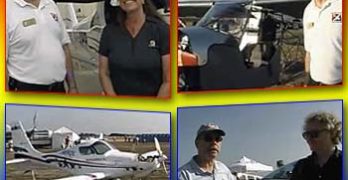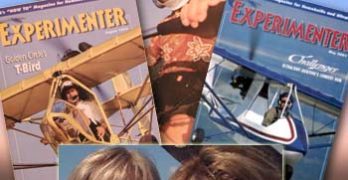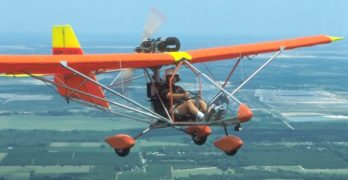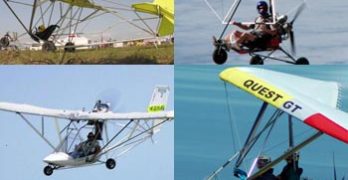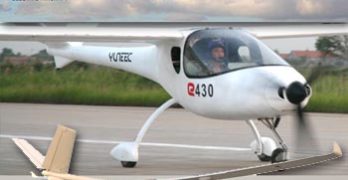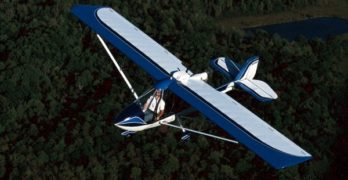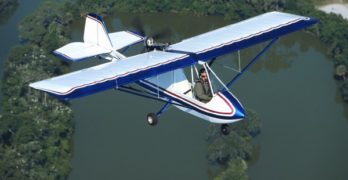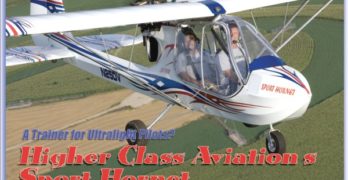I readily admit to being a hang glider pilot at heart. After flying several hundred airplanes,
I still consider flying a hang glider to be perhaps THE purest way to fly.
I’ve always said that if I could just snap my fingers and be in the air — oh,
that it was so simple and quick! — I would always choose a hang glider to
experience the magic of flight. *** But how about “hang ‘copter” flying? Huh!?!
I’ve got almost no time in rotary aircraft but I was caught by some video showing a
fellow flying a hang glider with a rotor blade doing the lifting instead of Dacron wings.
It struck me as kind of crazy …yes, even a hang glider pilot who loves flying off
a mountain. But there it is, looking pretty sane, actually. Near the end of the video,
the pilot waves comfortably to the camera before executing a very normal looking
landing (well, normal to a hang glider pilot if not a jet jockey).
Search Results for : Part 103
Not finding exactly what you expected? Try our advanced search option.
Select a manufacturer to go straight to all our content about that manufacturer.
Select an aircraft model to go straight to all our content about that model.
Going Multimedia (Reluctantly at First)
Lots of other aviation news organizations embraced multimedia before ByDanJohnson.com did. We figured online was already quite lively with hyperlinks and true interactivity as represented by our exclusive PlaneFinder 2.0 feature. *** About a year ago, of UltralightNews approached me with an idea to do brief reviews of LSA. I accepted his invitation and today we are well on our way to having a 4-8 minute video mini-review for each of the 105 SLSA on the market. Other professional outlets like AvWeb, ANN, AOPA, and EAA offer multimedia topics all over the aviation map, but ByDanJohnson.com maintains a tight focus on all manner of light aircraft flown by Sport Pilots. *** With that manifesto in mind, we observe for you that we just posted new reviews on our LSA Videos page and we invite you to watch these… for free and without even having to register.
EAA Sport Pilot Merges into Sport Aviation
Before you clicked to ByDanJohnson.com, you may have been reading EAA’s Sport Pilot magazine. If your copy was the December 2009 issue, it the final edition of the magazine that started with the Sport Pilot movement. *** EAA surveyed to ask what members wanted from their publications. The organization dutifully recorded all responses and chose to make a dramatic decision. They elected to stop Sport Pilot and merge the LSA title’s most popular content into their flagship rag. *** At the same time, EAA started “Light Plane World,” an eNewsletter (also online) with info about ultralights and LSA. Edited by longtime Part 103 enthusiast Dan Grunloh, LPW is intended to provide more detailed info on ultralights and light planes than space will permit in Sport Aviation. You can sign up here to get LPW… or any other EAA eNewletter. *** As this chapter closes for EAA, I wish to bring special attention to a 25-year veteran EAA editor who was one of handful nurturing the light end of EAA’s aviation activities.
Aero-Lite Revisited
[UPDATE fall 2009 — Aero-Works left the business several years ago (though in late 2009, originator Terry Raber said he will return to production). Meanwhile, producer Wings of Freedom has begun work on the Phoenix-103, a derivation of the Aero-Lite 103 but with numerous small changes.
This article refers to the aircraft built by AeroWorks and will not be identical to the Aero-Lite 103. The companies are different and Terry Raber has no association with Wings of Freedom.
In the uncertain “new world of Sport Pilot,”
one thing remains exactly as it was – FAR Part 103. While new rules and regulations may shake the ground under the feet of ultralight pilots, Aero-Works continues to produce their popular AeroLite 103. If you build it carefully, you can still enjoy a twin-cylinder ultralight with lots of features that fits Part 103.
Even airline pilots who normally fly under smothering regulations appreciate FAA’s simplest, least intrusive rule, Part 103.
Ultralight Trainers…Exemptions?…SLSA Trainers
Ah, sweet Part 103 ultralights. These lightest of powered aircraft have the least FAA regulation of any flying machine. A single piece of letter paper holds the entire rule. But how do you learn to safely fly a single seater? Oh, there’s the rub. *** Through January 31, 2010, two-seat ultralights converted to ELSA status may train pilots for hire. Then they must cease… maybe. Some feel that the nation lacks enough such trainers so Aero Sports Connection petitioned for an extension. Sounds reasonable. *** But what about companies that spent resources to win FAA approval? It sounds like those who played by the rules as FAA wished could miss their reward of taking over such training aircraft sales. The controversy has complications and you probably don’t want to read it all. *** But here’s what industry organization LAMA has to say: “In the 4.3 years since the first approval, 100 SLSA models have been approved.
Arriving from Shanghai…Electric Power Two Seater
Two Chinese delegates attended ASTM meetings in Freidrichshafen Germany in April, the first time the nation has been represented. Those reps indicated they believed ASTM acceptance in China may not be far off. Meanwhile, Shanghai-based Yuneec company is moving forward, and upward. *** Yuneec’s E430 will be featured at AirVenture along with a distinctly American design: the Flightstar Spyder (single place, Part 103-capable ultralight) fitted with a Yuneec electric motor. *** Using a 6-battery setup on their two seater, E430 expects 1.5-2 hours of flight and with such an installation, payload is a respectable 400 pounds even with a 45-foot wing span. A 10-battery setup may fly 2.25-2.5 hours. A video gives a hint to the sound level (turn your speakers up loud). *** Yuneec International announced, “The E430 is a twin seat, single engine, LSA class aircraft designed to be simple to use, easy to fly and with virtually zero vibration.
Modestly-Priced, Easy-Flying Challenger Series
For 21 Years, Quad City’s Challenger has proved a good choice.
It’s enough to create a serious case of envy among producers vying for the market the Challenger seems to own year after year. Even in 2003, a slow year for all aircraft manufacturers, Quad City Ultralight Aircraft pumped out another 120 kits. Most light-sport aviation companies would consider that an excellent performance. For Quad City, it was a down year!
The venerable company from the Quad Cities area of Iowa, near the Illinois border, has put more than 3000 aircraft in the air. Van’s Aircraft has done even better, and Quicksilver has more than 10,000 ultralights flying, but the Challenger is clearly one of the industry’s leaders. And the company has enjoyed the same leadership since it was founded more than two decades ago.
Despite this success, Quad City maneuvers rather quietly. Last year the company celebrated 20 years of operation, yet many ultralighters and most aviators were unaware of the accomplishment.
Successful Low-Cost Light Planes
“I started the company in 1983, and I still own it,” reports Dave Goulet, the main man behind the Challenger aircraft design and Quad City Ultralight Aircraft Corporation. “In fact,” he adds, “it’s probably the oldest ultralight company still under the same management. “After reviewing all the ultralight companies I can think of, I’m inclined to agree.”
Thinking of other long-term operations, Goulet mentions The New Kolb Aircraft Company, whose roots are also planted deep, but even that storied company has now changed ownership… twice in the last decade, and most recently just a couple years ago.
Quicksilver Mfg. has been around longer, but the revolving door of managers and several changes of ownership have long since taken that familiar brand out of contention for continuous leadership.
About the only challenge to Challenger’s continuity reign that I can think of would be Chuck Slusarczyk, designer of the Hawk series, and his company, CGS Aviation.
T-Bird I and the Future
An Easy-Flying Ultralight
Let’s see. A single-seat plane that can be purchased as an ultralight,
assuming your engine selection doesn’t push it over Part
103’s weight limit, or built from a kit and registered as an
Experimental-class aircraft, or purchased as a light sport aircraft
once the manufacturer meets the ASTM certification. What’s a pilot to do?
That’s the conundrum facing T-Bird I shoppers. This single-seater can be
a Part 103-compliant ultralight when using a Rotax 277, still available on
the used-engine market, though no longer supplied from Rotax’s Austrian
factory. Few prospective owners would select this engine, yet a more powerful
engine would push the T-Bird I over the Part 103 weight limit. Does that
leave only the Experimental amateur-built kit
option?
The answer is no, and yes. To explain this apparent
contradiction, a kit-built T-Bird I with a larger
Rotax engine or the 60-hp HKS 700E engine could
still qualify under the 51% rule.
NH:Higher Class Aviation’s Sport Hornet
At the close of business on January 31,
2008, 2-seat ultralight trainers and overweight
single-seater “ultralights” – as
readers of this publication understand these aircraft
– will cease to exist. More correctly, they
must have been converted to Experimental-Light
Sport Aircraft (ELSA) if their owners want to continue
flying them; otherwise these pilots’ options
are sharply limited.
But as Part 103-compliant ultralights continue
and if ultralight trainers go away, how will new
ultralight pilots be trained for flight in these
lightest of aircraft?
Happily, the subject of this month’s flight
review answers that question. Arguably the first
fixed-wing ultralight to make the jump – not to
ELSA conversion status but to full, Special-LSA
(SLSA) approval – is Higher Class Aviation’s
Sport Hornet.
Gaining Higher Class
We first saw the Hornet when Jim Millett
brought this new design to Sun ‘n Fun ’94 (the
event’s 20th anniversary). It was a bold move into
a market looking well established.
- « Previous Page
- 1
- …
- 29
- 30
- 31
- 32
- 33
- …
- 53
- Next Page »


